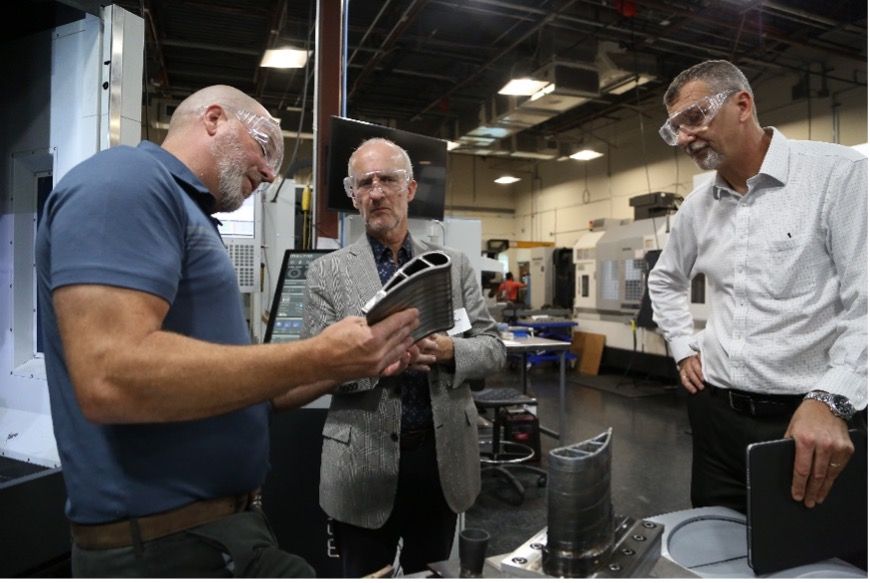Turbo Tour: Siemens Energy Innovation Center
Our site tour of Siemens Energy focused on additive manufacturing, prototyping new technologies, and decarbonization.
Siemens Energy has expanded its Innovation Center in Orlando, Florida. As the company’s first global hub for innovation, it is dedicated to accelerating the development of products and solutions to drive the energy transition through collaboration, rapid prototyping, and testing.
Siemens Energy Innovation Center CTO Cliff Hatcher showcases new 3D printing techniques being applied to blades.

The company has spent more than $30 million over the last few years in building its research & development operations in Florida. Another $7 million during 2022 added an extra wing as well as equipment for the machine shop, further additive manufacturing (AM) machines, and more robotics to inspect and repair components for equipment like turbines capable of running on hydrogen. The expansion increases the space from 17,000 sq. ft. to 30,000 sq. ft.
“We operate with a start-up mentality, where ideas that used to take six months to test now take six weeks,” said Rich Voorberg, President, North America for Siemens Energy.
ON-SITE VISIT
Turbomachinery International visited the center during its grand opening in October 2019. On our return in September of 2022, it was immediately clear that things had changed considerably. The company has substantially increased its manufacturing capability, increasing the volume of work in terms of man hours by around three times. A tour highlighted the fact that further space reorganization was ongoing to make room for yet more equipment.
“We have skills in-house that span mechanical engineering, electrical engineering, AI, welding, and a multitude of other disciplines,” said Voorberg. “We need all kinds of machinery to hand so we can develop prototypes rapidly and efficiently.”
Cliff Hatcher, CTO of the Innovation Center, led the tour. He said that the center was originally an experiment to see the effect of putting experts from multiple disciplines under one roof. Based on its success over the past three years, similar centers are being established in Berlin, Abu Dhabi, and China. In addition to new product and process developments, they will function as showrooms for what Siemens Energy is doing in the field of transformative technology.
“We wanted to be agile and have a footprint that could change as market needs changed,” said Hatcher. “We can work on one topic this week, and pivot immediately to another as required.”
AM represents a recent pivot. The center is working more extensively with AM to streamline the supply chain for 3D printed parts. It will help determine which parts should be made where based on quantity and complexity, as well as prototyping new parts to be printed and developing new techniques and processes. The company is also involved in the White House’s AM Forward initiative to help small businesses learn and adopt AM. This is just one facet of a shift from being a purely internal operation to using the center to engender creativity with customers and across the supply chain.
A customer site in South America, for example, had a legacy guide vane that was damaged during the disassembly process. The manufacturing plant no longer had the capability to make the part on an expedited schedule. After an exhaustive search for an existing part the service team ran out of options to meet the outage time schedule. They turned to Innovation Center Orlando to manufacture a new part that would meet the outage schedule of 15 days. The Innovation Center team 3D printed a replacement and shipped to their manufacturing facility in Charlotte to finish machining. In parallel, the center also machined a part from a block of steel on its 5-axis CNC machine. The parts arrived on time, costly damages were avoided, and the customer met its outage schedule.
NEW 3D PRINTING APPROACH
During the tour, we previewed work being done to make the 3D printing of blades feasible. Previously, 3D printing was only really viable for smaller parts due to the process involved: a layer of metallic powder of about 40 microns is laid down and laser sintered then another layer and another. For larger parts subject to high stress and temperatures such as blades, the center is using Wire Arc Additive Manufacturing (WAAM). It lays down 20 mm layers of molten metal at a time. The process is being refined and requires a lot more finishing than traditional 3D printing.
Rich Voorberg said customers are keen to co-fund and co-create projects such as blade advances as well as in carbon capture, hydrogen, and other areas of the energy transition.
“Some customers are working with us to push turbine development to be able to run on 100% hydrogen,” he said. “The challenge is not so much in burning hydrogen but in establishing the entire hydrogen supply chain.”
Easier said than done. Hydrogen supply is extremely limited. Siemens Energy has developed electrolyzers and is working to scale up green hydrogen production. The recent infrastructure package enacted into law provides a $3 per kilo green hydrogen incentive, which will help ease funding stress on this technology. Nevertheless, we are looking at a long runway before hydrogen or some other fuel will replace natural gas.
“The amount of hydrogen you need to burn in large gas turbines is incredible,” said Voorberg. “We see the most viable market for hydrogen power being in areas such as buses, trains, and forklift trucks. But we will gradually see more hydrogen being blended with natural gas where it is available and economical to do so.” ■
